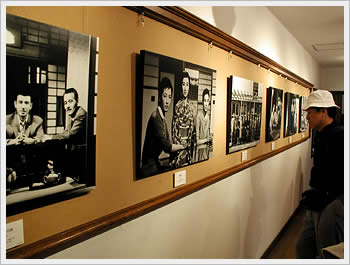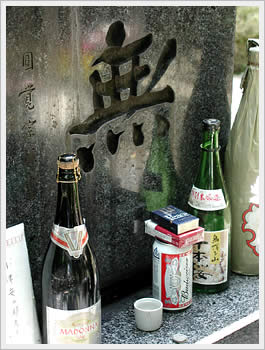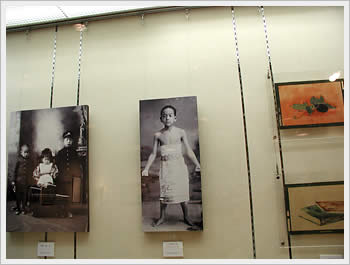Last Saturday I braved the heat and the crowds and made my way down to Kamakura, the once former capitol of Japan, and thus home to many wonderful temples and shrines, and to the Daibutsu (Big Buddha) statue. Kamakura is also home to many varieties of seasonal flowers, and it was one of them, the ajisai or hydrangea, that brought out the crowds in droves on this day. At the Meigetsuin temple, so reknown for it’s ample collection of hydrangea that its nickname is ajisai-ji or “Hydrangea Temple,” I could hear tourguides bellowing out through their bullhorns to their charges waiting in line that they would have to wait at least 1 hour before they could get into the temple. There were the requisite moans, but I didn’t see any of them get out of line.
Fortunately, I was in Kamakura for quite a different attraction, one much more subdued and less-traveled by comparison: an exhibition of miscellany related to the life and career of Japanese filmmaker Yasujiro Ozu, on view at the Kamakura Museum of Literature. The day before, I had been flipping channels on the TV when Naoko caught Ozu’s name on the screen and told me to stop. It was a news segment on the exhibition, which I had not been aware was going on. I was lucky, the exhibition was to end on the 29th of this month. There was still time to go see it, and so I did.
The museum is in Kamakura proper, not too far from the Daibutsu, but I began the day’s journey with a stop in Kita-Kamakura, and a visit to Engaku Temple, on the grounds of which is a cemetary with Ozu’s grave. Inspired by Jonathon Delacour‘s post “Visiting Ozu’s grave”, I had traveled down to Kamakura in July of last year in search of the gravesite, and after some missteps and wrong turns, and not a few rows of grave markers scrutinized heavily, I was finally able to find the austere granite block upon which is inscribed the Chinese character mu, which vaguely means “nothingness” or “non-existence.”
This time of course I was able to go straight there to pay my respects. In contrast to how the grave looked last year, on this occassion someone before me had left a kumotsu or “offering” of sake and beer and a couple packs of cigarettes. One of the cigarette packs was the Peace brand, and later at the exhibit the same distinctively packaged brand could be seen in a display of Ozu’s personal effects.
I continued on my way, with a vague plan to see the Hydrangea Temple, that is until I caught wind of the aforementioned tour guide’s announcement. So I passed the throng and continued my walk to Kamakura, meandering past some temples along the way, and continued to walk for a couple of kilometers to the Daibutsu (I had forgotten that when I first visited Kamakura in 1997, we had taken the Enoden train to the Daibutsu). After an almost obligatory visit to the Daibutsu, and some well-needed rest in the shade, I made my way over to the Kamakura Bungakukan, or Museum of Literature.
The museum is housed in a villa of the former Marquis Maeda, decendent of one of the most powerful feudal clans of the Edo era, and was originally built in 1890. The present Western-style structure dates from 1936, and was depicted by Yukio Mishima in his novel Spring Snow. While the property is large and spacious, the museum itself is quite tiny.
The Ozu exhibit, which was entitled mirai e gatari kakeru monotachi (loosely translated as “Things that speak to the future”), was of modest size, but did not disappoint. In two rooms, various examples of Ozu paintings and drawings were on display, as well as rare (to me, at any rate) photos of Ozu at various stages of his life. My favorite was a photo of Ozu as a 9-year old boy in a ceremonial sumo kesho-mawashi he had made out of paper.
There were display cases with various paraphernalia related to Ozu’s directorial work, notebooks, diaries, screenplay pages with drawings on them, his Leica rangefinder camera, the viewfinder he used when directing, the tripod his crew used to get the famed “tatami-mat” low-angle shots, and Ozu’s trademark white pikebou, or pique hat. I lingered for as long as I thought reasonable, trying to stave off the ephemerality of the visit.
I bought the small book that accompanied the visit, as well as a postcard set of reproductions of some Ozu drawings and watercolors, and have scanned those along with some other bits from the exhibit, and put them online. I’ve also finally created a site with directions on how to find Ozu’s grave at Engaku in Kita-Kamakura, which I had intended to put up online last year but never did. Both these sites can be accessed from here:
Note: I created these pages in some ways as a test for making a web page using both English and Japanese, and used Mozilla’s Composer for this. Composer is not my WYSIWYG html editor of choice, but it was a dream when it came to inputting both Japanese and English and having them render properly, even in code view. The pages look fine on my system (Windows, using Mozilla 1.3), but as I’m new to this, I would appreciate any feedback from users who might have trouble viewing the pages properly.
ADDENDUM: I should have noted that this Ozu exhibit will end on June 29th, so if you’re in the Tokyo area and interested, you’ll need to hurry. Also, when at the museum, I saw small handbills advertising some sort of Ozu event on the 29th, but I’m not sure exactly what kind of event, nor could I find any information online about it.




Unicode (UTF-8) definitely is the coming thing, and Mozilla handles it very nicely, but older systems have lots of issues with this character set: anything earlier than Windows 2000 is problematic.
My copy of Internet Explorer 6 on Win 98, for example, fails to render the Japanese characters on your new pages. This is strange because it does OK with the Japanese characters on Tawawa, as well as on Kyo-san’s site, whis has just been converted to UTF-8. Maybe this has something to do with Composer’s bad, non-structural markup: proper h and p tags instead of the fancypants classes might help.
Also: IE6/Win98, I’ve just noticed, doesn’t recognize the automargin property, so your layout table does not center. You may want to use [div align=”center”].
Next time you are out this way you should drop me a line. Maybe we can get a beer or something. (I’m in Zushi, one stop from Kamakura)
Kurt. The pages render perfectly in Safari on a Mac PowerBook G4 using OSX10.2.6.
For those of us who have no chance of getting to the exhibit, a hearty thanks so much. The other day in an antipixel comment, gomichild wrote that the younger generation of Japanese were starting to get into shopping at secondhand stores and appreciating the beauty of Japanese craftsmanship of the past. I hope that the “MIJ” movement will extend to rediscovering Ozu. Maybe exhibits like this are a sign that they are beginning to.
thanks for sharing a few selections of the recent exhibition catalog on your ozu pages. i found the continuity drawing from ozu’s notebook especially interesting. what do you make of the red x’s and circles? i’m guessing that these pages were used as a checklist during production and crossed off after shots were completed, or in post-production, and crossed off when re-assembled. does the writing in red clarify it’s purpose?
Thanks for everyone taking a look at it. Rudolf, yes, the code Composer generates leaves something to be desired. I’ve cleaned it up a bit, not sure if it made things better for you. As I understand it, though I could be wrong, by using UTF-8 Unicode, the user shouldn’t have to download anything special (eg. Japanese fonts), whereas with Shift-JIS for example, they would. Anyone know for sure?
Bob, you know I noticed Zushi on my train map and was like “so that’s where it is. That’s where Bob lives.” So next time! (and if Zushi is anything like Kamakura, I’m jealous!)
M, it’ll be interesting to see what effect, if any, this 100-year anniversary will have on his popularity, or lack thereof. One has to give Shochiku credit for their 4 box DVD release slated for later this year. Whether the younger generation takes to him, however, is not something I’m confident of. But no more than I would be of young Americans taking to Howard Hawks or Preston Sturges, let alone more esoteric fare, or Danes taking to Dreyer, or French taking to Bresson, etc.
Mark, you’re asking me to read handwritten Japanese!? actually, I can make out some of the scribble. One red marking next to a pic with an X through it clearly says オミット(“omitto” which means, you guessed it, omit). I’m not really familiar with how “continuity” works in Japanese studio production filmmaking, in other words was some crew member making these drawings during shooting (a job Hollywood refers to as the “script girl”), and as you note, the scenes were checked off later during editing. Or was this a storyboard, and the “script girl” is checking the scenes off during editing. Beats me! In the exhibit, but not reprinted in the catalog, were pages like these from Tokyo Story (東京物話) with clearly defined shots, so I have to think Ozu drew these, rather than some crew member.
Glad to see you posted these pages. I followed all of the threads. Couldn’t believe the crudeness of C’s comments on Jonathan Delacour’s musings on his “Visiting Ozu’s Grave.” Nor could I understand Natsuko’s rebuke that Ozu wouldn’t understand Jonathan’s prayer since it had been uttered in English. Why such native spite about a foreigner coming to grips with another culture? Thank’s also for introducing me to Ozu.
“As I understand it, though I could be wrong, by using UTF-8 Unicode, the user shouldn’t have to download anything special (eg. Japanese fonts), whereas with Shift-JIS for example, they would. Anyone know for sure?”
Regardless of the encoding type, people will still need to have installed Japanese fonts for the Japanese text to show up properly.
I read about the Ozu exhibition here: http://www.economist.com/cities/briefing.cfm?city_id=TK&calendar=1 . Hope to go on Sunday, the last day. Thanks to Kurt, I will be able to visit Ozu’s grave too! Thanks a lot for this superb post!!
Here is another blog about a trip to Kamakura on the very same day. http://www.redtailcanyon.com/items/12465.aspx
john-
that’s great! talk about coincidence